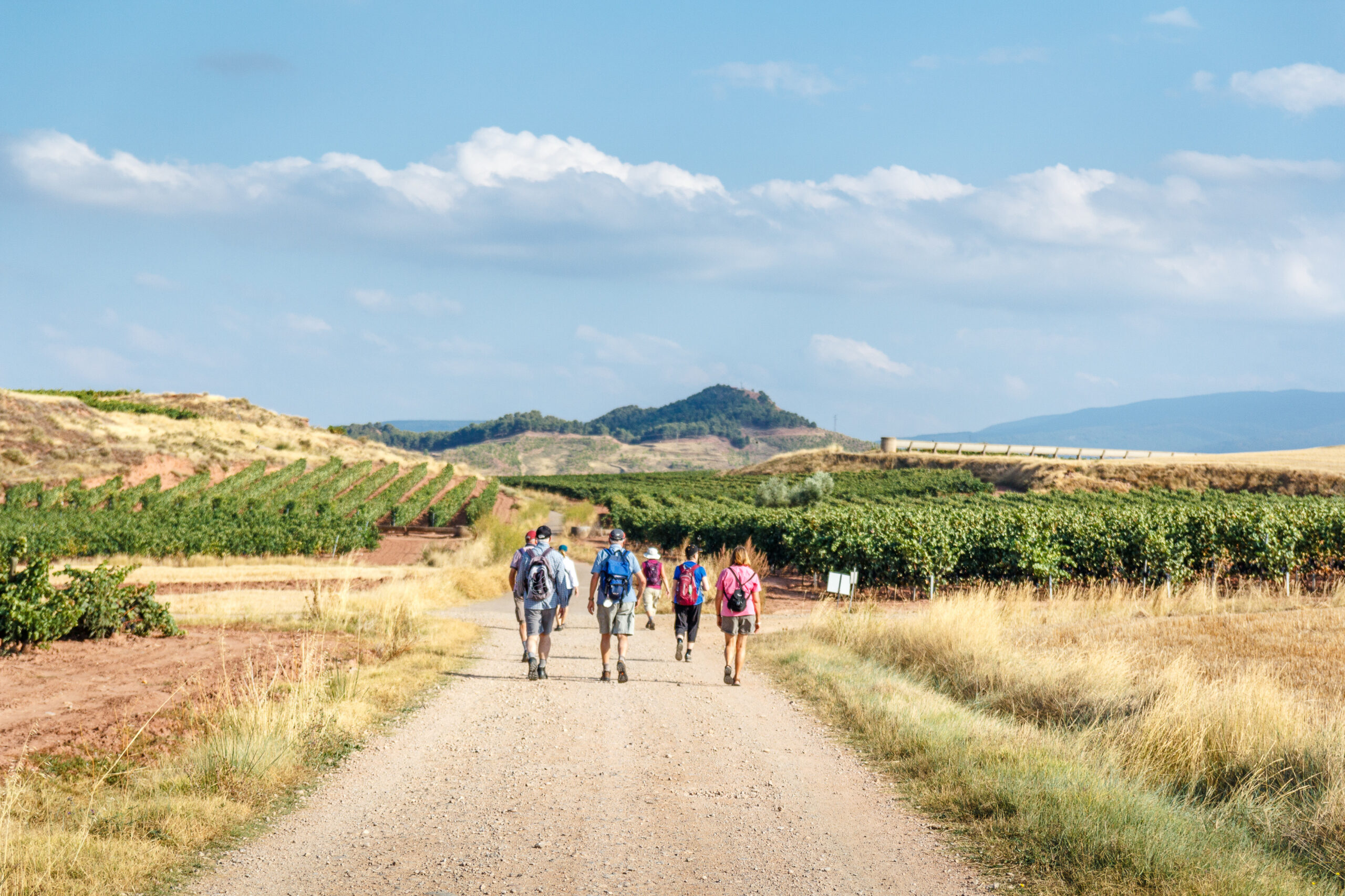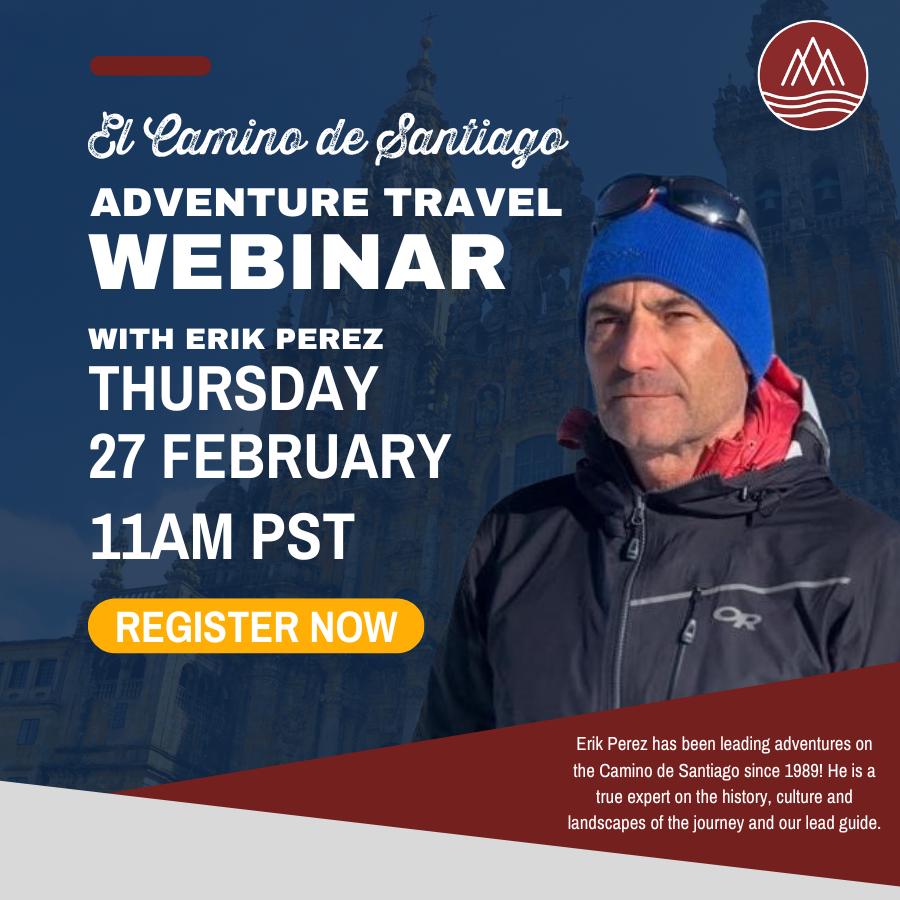Webinar: Hiking the Legendary Camino de Santiago

Join MT Sobek’s Europe experts, Erik Perez and Anne Wood, for an inspiring webinar on hiking the world-famous Camino de Santiago in Spain. Follow in the footsteps of centuries of pilgrims as you discover the magic of this legendary route—winding through rolling vineyards, medieval villages, and historic cities steeped in culture and tradition. Eat delicacies from northern Spain, including pintxos, and rest well at stunning 4- and 5-star hotels and Paradores. Gain insider tips and get ready to embark on a transformative journey with adventure experts who bring the Camino to life!

Walk the Camino de Santiago with MT Sobek: A Journey of Spirit, Culture, and Discovery
Hello! I’m Anne Wood, Senior Director of Trip Development and Operations at Mountain Travel Sobek. I’m so glad you’re here to learn more about our beloved Camino de Santiago trip in Spain. I’m joined (virtually) by one of our most seasoned and passionate guides, Erik Pérez, who’s been leading our Camino journeys for the past 14 years. With over 35 years of guiding experience in legendary mountain destinations—like Nepal, Patagonia, Greece, and his homeland of Spain—Erik brings unmatched depth to this historic route.
How Did a Mountain Guide End Up Leading the Camino?
Erik’s journey to the Camino started long before he ever laced up his hiking boots. He holds a master’s degree in history from the University of Oviedo, and although his parents once hoped he’d become a teacher, he followed his passion for the mountains and became a certified guide. But his love of history, politics, religion, and anthropology never left him. He still attends courses each year to stay connected to these interests.
When we began designing our Camino trip, we knew it had to be more than a hike—it needed to honor the spiritual and cultural significance of this pilgrimage. Erik was the natural choice.
History of the Camino de Santiago
Who Was Saint James, and Why Was He So Important to Spain?
Saint James (or Santiago) is the patron saint of Spain and one of Jesus’ twelve apostles. He was born in Galilee around 5 BC, making him five years older than Jesus. After Jesus’ death, Saint James traveled to Spain (then part of the Roman Empire) to spread Christianity. He wasn’t particularly successful at the time, and eventually returned to Jerusalem, where he was imprisoned and executed. Two of his followers brought his remains back to Spain in 44 AD, hiding them in the northwest region of Galicia.
Centuries later, in 813 AD, his remains were “rediscovered,” and the site became the destination for one of the most important Christian pilgrimages in the world—third only to Jerusalem and Rome.
What Is the Camino Frances, and Why Is It The Most Popular Route?
The Camino de Santiago isn’t just one path—it’s a network of routes converging on the city of Santiago de Compostela. The Camino Francés, or French Way, is the most famous of these, stretching across northern Spain from the French Pyrenees to Santiago.
Our journey begins in the charming French town of Saint-Jean-Pied-de-Port and crosses the Pyrenees into Spain, winding through historic cities like Pamplona, Burgos, and León. About 80% of all modern pilgrims take this route, and it’s the one we’ve chosen for our carefully curated itinerary.
Everything about Hiking the Camino de Santiago
Hiking the Camino de Santiago
Walking the Camino isn’t a technical hike—it’s more of a long, meaningful walk. The terrain is mostly gentle, with well-maintained trails and scenic paths through countryside, villages, and historic towns. Even the climb over the Pyrenees and a few steeper sections are very manageable with moderate fitness.
To prepare, I recommend walking about 4–5 miles a few times a week, starting a few months ahead. Most days on the trip cover 10–12 miles, with an option to hike up to 16 miles on flatter days in Spain’s central plateau.
Essential Packing List for the Camino
The key is to keep it light. Most guests wear comfortable trail-running or hiking shoes—something breathable and waterproof. If you prefer boots for ankle support, be sure they’re well broken-in. We carry only small daypacks with essentials like water, a rain jacket, and maybe a light snack. Your main luggage is transported for you, and we have van support if you ever need a break.
While most guests get emotionally invested in completing each leg, MT Sobek has support vehicles that can pick you up at designated points. We make it easy to tailor the experience to your comfort level.
What’s the Terrain Like?
You’ll walk through varied terrain: forests, farm roads, village lanes, and yes, even past the occasional airport or industrial area. This is intentional. We’ve chosen the most beautiful and iconic sections, but we also want you to feel what it’s really like to walk across Spain. It’s not just a curated experience—it’s a pilgrimage.
The Significance of Walking the Camino
People come to the Camino for many reasons—spiritual renewal, cultural curiosity, fitness, or personal reflection. Some are drawn by the movie The Way, others by stories they’ve heard. Many come with something personal on their heart. Whatever the motivation, most find the journey incredibly meaningful.
Even those who don’t come for religious reasons often find themselves deeply moved. There’s a shared spirit among pilgrims that fosters connection, contemplation, and transformation.
What Are Some Cultural Highlights Along the Route?
In addition to walking through Spain’s stunning countryside, we explore its rich heritage. Our itinerary includes guided tours of Gothic cathedrals, Romanesque churches, and medieval towns. Each evening, we gather over delicious local meals and wines—another cornerstone of the experience.
What’s the Food Like Along the Camino?
It’s exceptional! From pintxos (Basque tapas on bread with toothpicks) to roasted meats, fresh seafood, and traditional stews, the Camino is a culinary adventure. We sample local specialties as we pass through different regions—from the Rioja wine country to Galicia, where we savor albariño wines and octopus dishes.
We dine in a mix of cozy taverns, family-owned restaurants, and converted monasteries turned into elegant hotels.
Exploring Camino de Santiago with MT Sobek
We call it “The Camino Without the Suffering.” You get the soul of the pilgrimage—iconic trail sections, cultural depth, and beautiful landscapes—without sacrificing comfort. You’ll stay in carefully selected accommodations, including historic inns and luxurious paradores. Our support vehicle is never far, and our team—including guides like Erik—ensures you’re cared for every step of the way.
You’re also walking in the footsteps of pilgrims described in the 12th-century Codex Calixtinus, a medieval travel guide. We designed our route to honor this legacy while making it as enriching and enjoyable as possible.
Frequently Asked Questions
- Spring or Fall? This is one of the most frequently asked questions we get, and honestly, both seasons offer something special. Spring brings beautiful green countryside and wildflowers, while fall offers golden landscapes and cooler hiking temps. The best choice really depends on your personal preferences—and we’re always here to help you decide which departure is the right fit for you.
- Compostela Certificate: Many travelers ask about the Compostela, the certificate of completion for the Camino. The rules for receiving it have changed recently, and while it can still be a little tricky to obtain, it’s definitely possible. If you’re aiming for that certificate, our team here in the U.S. can guide you through the steps.
- Hiking the Full Camino: One of the most heartwarming things I’ve experienced is seeing guests return to the Camino after traveling with us—this time on their own to complete the full 30-day route. Our journey is 11 days long, with 9 days of hiking, and it often serves as a gateway to something deeper. It’s so inspiring to hear, “I came back because I learned how to do it with you.” That kind of transformation never gets old.
- Can I Skip Some Sections, or Walk The Whole Way? Absolutely—you don’t have to hike every section. Some travelers choose to take a break now and then, and we always support that. Whether you need a rest day or want to skip a stretch, we can accommodate that without compromising your overall experience.
- Vegan Diets: Yes, MT Sobek can accommodate vegan diets. Admittedly, Spain is a country that loves its meats—chorizo and jamón are everywhere—but there are plant-based options available along the way. Vegetables are easy to find, and we work closely with each guest to make sure their dietary needs are met. It might take a bit more planning, but it’s certainly doable.
- Back-to-Back Options: Mountain Travel Sobek offers two back-to-back departures each year—one in August and one in October. If you’re interested in combining the Portuguese Camino with the Camino Francés, just let us know. We’d be happy to help you coordinate a seamless journey.
- Private Options: We’ve organized a number of private departures along the Camino, and it’s a wonderful way to experience this legendary pilgrimage route with just your close friends or family. Our guide team is always ready. One thing I can guarantee—you won’t get lost with us on the Camino.
Arriving at Santiago de Compostela
When we arrive in Santiago, we stay right beside the cathedral—the symbolic end of the journey. For those who wish, there’s a chance to attend mass, and everyone is recognized as a pilgrim. For many, it’s an emotional and unforgettable moment. The next day, we visit Finisterre, the “End of the Earth,” for a quiet, reflective finish to our trip.
It’s been such a joy sharing about the Camino with you. Whether you’re a seasoned pilgrim or considering your first steps on the trail, there’s something truly special about this journey. If you missed part of our webinar or had trouble viewing it, we’ve got you covered—the recording is available, and we’d love to send it your way.
Ready to walk the Camino with us? If you’re thinking about joining one of our Camino de Santiago departures, do it! But don’t wait too long! This is one of our most popular trips and it does fill quickly.
And of course, if you still have questions or want to speak with one of our expert Trip Consultants, feel free to give us a call at 800-974-0300. We’d love to help you find your way to the Camino.
Buen Camino—see you on the trail!
Where: View the recording
When: February 27, 2025
Note: This event has passed. If you'd like to view it, please see the recorded webinar by clicking here.